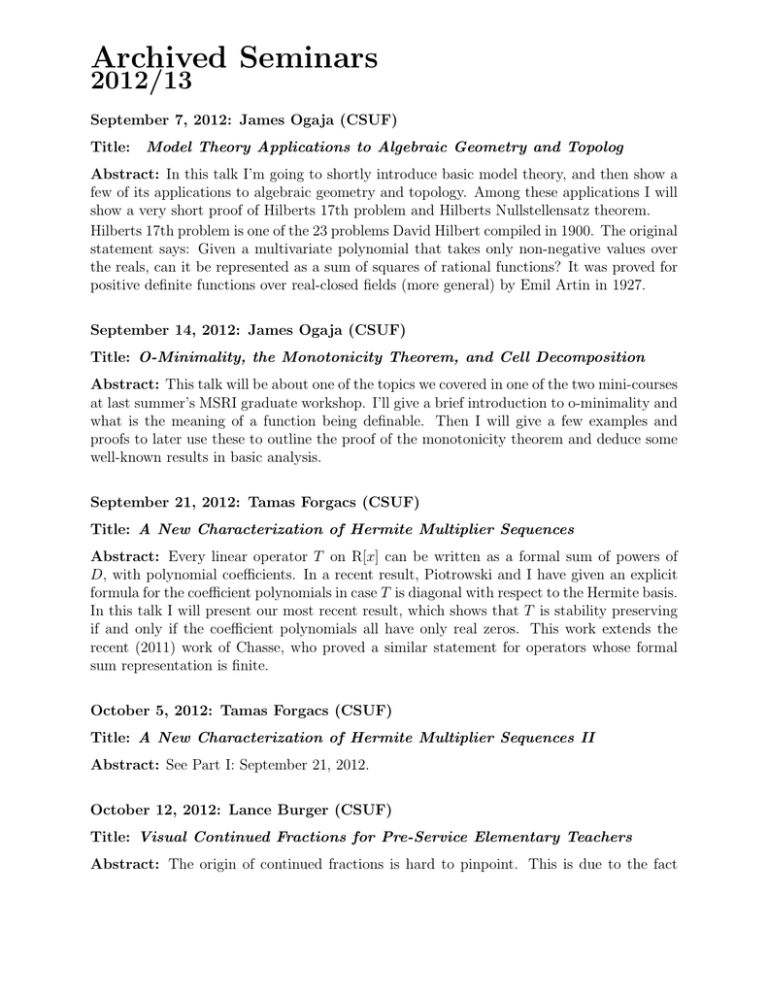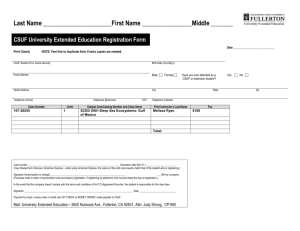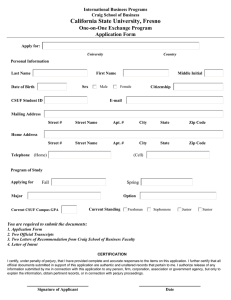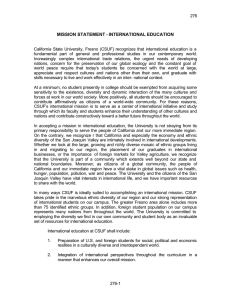Archived Seminars 2012/13
advertisement

Archived Seminars 2012/13 September 7, 2012: James Ogaja (CSUF) Title: Model Theory Applications to Algebraic Geometry and Topolog Abstract: In this talk I’m going to shortly introduce basic model theory, and then show a few of its applications to algebraic geometry and topology. Among these applications I will show a very short proof of Hilberts 17th problem and Hilberts Nullstellensatz theorem. Hilberts 17th problem is one of the 23 problems David Hilbert compiled in 1900. The original statement says: Given a multivariate polynomial that takes only non-negative values over the reals, can it be represented as a sum of squares of rational functions? It was proved for positive definite functions over real-closed fields (more general) by Emil Artin in 1927. September 14, 2012: James Ogaja (CSUF) Title: O-Minimality, the Monotonicity Theorem, and Cell Decomposition Abstract: This talk will be about one of the topics we covered in one of the two mini-courses at last summer’s MSRI graduate workshop. I’ll give a brief introduction to o-minimality and what is the meaning of a function being definable. Then I will give a few examples and proofs to later use these to outline the proof of the monotonicity theorem and deduce some well-known results in basic analysis. September 21, 2012: Tamas Forgacs (CSUF) Title: A New Characterization of Hermite Multiplier Sequences Abstract: Every linear operator T on R[x] can be written as a formal sum of powers of D, with polynomial coefficients. In a recent result, Piotrowski and I have given an explicit formula for the coefficient polynomials in case T is diagonal with respect to the Hermite basis. In this talk I will present our most recent result, which shows that T is stability preserving if and only if the coefficient polynomials all have only real zeros. This work extends the recent (2011) work of Chasse, who proved a similar statement for operators whose formal sum representation is finite. October 5, 2012: Tamas Forgacs (CSUF) Title: A New Characterization of Hermite Multiplier Sequences II Abstract: See Part I: September 21, 2012. October 12, 2012: Lance Burger (CSUF) Title: Visual Continued Fractions for Pre-Service Elementary Teachers Abstract: The origin of continued fractions is hard to pinpoint. This is due to the fact that one can find examples of these fractions throughout mathematics in the last 2000 years, but its true foundations were not laid until the late 1600’s, early 1700’s. Their origin is traditionally placed at the time of the creation of Euclid’s Algorithm. Since the beginning of the 20th century continued fractions have made their appearances in other fields. To give an example of their versatility, a recent paper by Rob Corless examined the connection between continued fractions and chaos theory. Continued fractions have also been utilized within computer algorithms for computing rational approximations to real numbers, as well as solving indeterminate equations. This talk discusses how the author uses continued fractions in a variety of ways with preservice teachers as a means to interface with several visual models learned in their methods coursework, as well as form visual transitions for understanding other topics, such as rational and irrational numbers. October 19, 2012: Larry Cusick (CSUF) Title: Quandle Theory Abstract: Quandles are an algebraic invention for distinguishing equivalence classes of knots. Like many mathematical creations, quandles have now taken a life of their own. I will discuss elementary quandle theory. It is an algebraic theory, perhaps like group theory, still in its infancy. My approach is computational. November 2, 2012: Oscar Vega (CSUF) Title: Kuratowski-Like Problems in Finite Projective Planes Abstract: A well-known theorem in Graph Theory, due to Kuratowski, characterizes which graphs can be drawn on the Euclidean plane having edges intersecting only at vertices. This problem has also been studied, using topological techniques, on the real projective plane. This talk is on recent advances towards solving this problem on finite projective planes. November 9, 2012: Oscar Vega (CSUF) Title: Kuratowski-Like Problems in Finite Projective Planes II Abstract: In part I of this Kuratowski-like problems in the Euclidean plane, tori, and the real projective plane were discussed. Now, the idea of embedding of a graph in a finite projective plane will be re-introduced, and techniques developed for this study will be shown. These include the use of finite fields in coordinatizing finite planes, and the use of group actions to help with the counting of the distinct embeddings of a given graph in a given plane. Next week, on November 16th, undergraduate students who spent their summer in our Math REU will present their results on the same topic. November 16, 2012: David Heywood and Jamie Peabody (CSUF Students) Title: Various Results on Embeddings of Graphs in Projective Planes and Spaces Abstract: First Part: Understanding P G(2, q) as the projective extension of GF (q)×GF (q) allows us to study embeddings of wheel graphs and gear graphs in P G(2, q). We have proved that the obvious bounds for these embeddings to exist are sharp, and constructed fairly explicit embeddings for all ’smaller’ gears and wheels. Second Part: Using a vector space approach to P G(n, q), for n > 2, we are able to prove that k-cycles may be embedded in these geometries, for almost all values k that are less than the number of points in P G(n, q). The work presented in these mini-talks was done over the summer at our Math REU by: Elaina Aceves (CSU Fresno), David Heywood (CSU Fresno), Ashley Klahr (U of San Diego), Jamie Peabody (CSU Fresno), and Jordan White (CSU Monterrey Bay). November 30, 2012: Megan Kuneli and Katie Urabe (CSUF Students) Title: On the Homfly-pt and Kauffman Link Polynomials Abstract: The Homfly-pt and the Kauffman polynomial are two-variable polynomial invariants for oriented and unoriented links, respectively. We will define these polynomials and give state models for them, that are summations over diagrammatic states obtained from a link diagram by operations of splicing and labeling. December 7, 2012: Serena McTeer, Jamie Peabody, and Karen Willis (CSUF Students) Title: The Category of sl(3)-webs Abstract: The sl(3)-polynomial for oriented knots and links can be defined via a calculus of planar trivalent graphs, called sl(3)-webs. Inspired by this, we introduce and study the category of sl(3)-webs with boundary, and construct a functor from the category of oriented tangles into this category. December 7, 2012: Elaina Aceves and Jennifer Elder (CSUF Students) Title: Invariants for Spatial Graphs Abstract: A spatial graph is an embedding of a graph in the three-dimensional space. We use well-known invariants for knots and links to construct invariants for a certain type of spatial graphs. March 6, 2013: Ms. Abeer Hasan (Bowling Green State University) Title: Flexible Families of Skew t Distributions with Applications Abstract: The problem of fitting skew symmetric data with long tails has gained increasing interest over the past three decades. The limitations of the normal model in financial data analysis motivated the search for more flexible alternatives. One approach to address this problem is providing a skewed version of the student t distribution. Different approaches to define skewed versions of the Student t distribution will be discussed. Some theoretical results and computational issues will be listed. A brief illustration of the many applications and examples of data analysis using the skew t distribution will be presented. Finally, some of the possible directions for future research in the area will be discussed. March 8, 2013: Ms. Naomi Brownstein (University of North Carolina at Chapel Hill) Title: Analysis of Time-to-Event Data & Intermediate Phenotypes in the OPPERA Study Abstract: In a prospective cohort study, examining all participants for incidence of the condition of interest may be prohibitively expensive. For example, the “gold standard” for diagnosing temporomandibular disorders (TMD) is a clinical examination by an expert dentist. In a large prospective cohort study, examining all subjects in this manner is infeasible. Instead, it is common to use a cheaper (and less reliable) examination to screen for possible incident cases and perform the “gold standard” examination only on those who screen positive on the simpler examination. Unfortunately, subjects may leave the study before receiving the “gold standard” examination. This results in a survival analysis problem with missing censoring indicators. Motivated by the Orofacial Pain: Evaluation and Risk Assessment (OPPERA) study, a large cohort study of TMD, we propose methods for parameter estimation in survival models with missing censoring indicators. We estimate the probability of being a case for those with no “gold standard” examination through a logistic regression model. Predicted probabilities facilitate estimation of the hazard ratios associated with each putative risk factor. Multiple imputation produces variance estimates for this procedure. Simulations show that our methods perform better than nave approaches. In addition, we apply the method to data in the OPPERA study and extend the methods to account for repeated measures and missing covariates. Another problem of recent interest is the analysis of secondary phenotypes in case-control studies. Standard methods may be biased and lack coverage and power. We propose a general method for analysis of arbitrary phenotypes, including ordinal and survival outcomes. We advocate the use of inverse probability weighted methods and estimate the standard error by bootstrapping. March 11, 2013, 9:00am: Mr. Qi Zheng (Clemson University) Title: Adaptively Weighted Kernel Regression Abstract: Local polynomial regression is a useful non-parametric regression tool to explore data structures and has been widely used in practice. We develop a new kernel-based local polynomial methodology called adaptively weighted kernel regression to improve nonparametric regression. The proposed method employs several weighted loss functions simultaneously, where the optimal weights are data driven and chosen to provide maximum efficiency. Theoretically, we show that our estimator is at least as efficient as those provided by existing procedures, but can be much more efficient for a larger class of distributions. We also demonstrate that the optimal weights adapt to the tails of the error distribution resulting in a procedure which is both robust and resistant. Simulation studies were conducted to examine the performance of the proposed estimator. The results from these studies are consistent with our theoretical findings. To further illustrate our proposed methodology, we use our model to analyze the change in global temperature anomalies over the last 100 years. April 5, 2013, 11:00am: Tamas Forgacs (CSUF) Title: A Classification of Generalized Laguerre Multiplier Sequences Abstract: In this talk I will present a recent result of Borcea and Ottergren, giving a characterization of Laguerre multiplier sequences. This work is a culmination of some earlier efforts of Forgacs and Piotrowski. I will concentrate on the main ideas, interesting techniques and extendability of the methods to other bases. April 12, 2013, 11:00am: Tamas Forgacs (CSUF) Title: A Classification of Generalized Laguerre Multiplier Sequences, (Part II) Abstract: In this talk I will present a recent result of Borcea and Ottergren, giving a characterization of Laguerre multiplier sequences. This work is a culmination of some earlier efforts of Forgacs and Piotrowski. I will concentrate on the main ideas, interesting techniques and extendability of the methods to other bases. April 19, 2013, 3:00pm: Doreen De Leon (CSUF) Title: Introduction to Iterative Methods for Solving Sparse Linear Systems Abstract: Sparse matrices (those having a large number of zeros) arise in a number of applications. Examples appear in combinatorics, network theory (in situations with a low density of connections), and science and engineering (where such systems result from numerical methods for solving partial differential equations in two or three dimensions). The memory and computational requirements for solving such equations have resulted in the development of iterative methods, which can be more easily and efficiently implemented. In this talk, I will review some relevant background material before introducing a variety of iterative methods for solving sparse linear systems.



